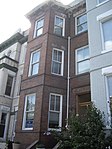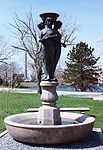St. Mary's Cemetery (Washington, D.C.)
1870s establishments in the United StatesCatholic cemeteries in the United StatesCemeteries established in the 1870sCemeteries in Washington, D.C.Northeast (Washington, D.C.) ... and 2 more
Use American English from October 2024Use mdy dates from October 2024

St. Mary's Cemetery (also known as the Saint Mary Mother of God German Catholic Church Cemetery and the St. Mary's German Catholic Cemetery) is a Catholic cemetery in Washington, D.C., United States, overseen by the Roman Catholic Archdiocese of Washington.
Excerpt from the Wikipedia article St. Mary's Cemetery (Washington, D.C.) (License: CC BY-SA 3.0, Authors, Images).St. Mary's Cemetery (Washington, D.C.)
Bryant Street Northeast, Washington
Geographical coordinates (GPS) Address Nearby Places Show on map
Geographical coordinates (GPS)
| Latitude | Longitude |
|---|---|
| N 38.921666666667 ° | E -77.006111111111 ° |
Address
Glenwood Cemetery Mortuary Chapel
Bryant Street Northeast
20002 Washington
District of Columbia, United States
Open on Google Maps










